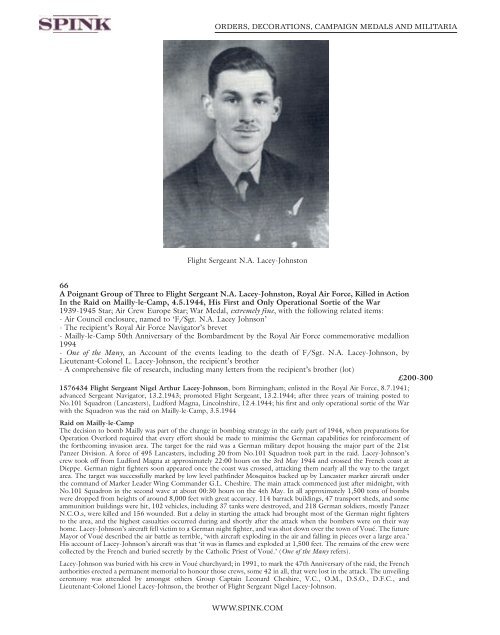orders, decorations, campaign medals and militaria - Spink
orders, decorations, campaign medals and militaria - Spink
orders, decorations, campaign medals and militaria - Spink
Create successful ePaper yourself
Turn your PDF publications into a flip-book with our unique Google optimized e-Paper software.
<strong>orders</strong>, deCoratioNs, CampaigN medaLs aNd miLitaria<br />
Flight Sergeant N.A. Lacey-Johnston<br />
66<br />
A Poignant Group of Three to Flight Sergeant N.A. Lacey-Johnston, Royal Air Force, Killed in Action<br />
In the Raid on Mailly-le-Camp, 4.5.1944, His First <strong>and</strong> Only Operational Sortie of the War<br />
1939-1945 Star; Air Crew Europe Star; War Medal, extremely fine, with the following related items:<br />
- Air Council enclosure, named to ‘F/Sgt. N.A. Lacey Johnson’<br />
- The recipient’s Royal Air Force Navigator’s brevet<br />
- Mailly-le-Camp 50th Anniversary of the Bombardment by the Royal Air Force commemorative medallion<br />
1994<br />
- One of the Many, an Account of the events leading to the death of F/Sgt. N.A. Lacey-Johnson, by<br />
Lieutenant-Colonel L. Lacey-Johnson, the recipient’s brother<br />
- A comprehensive file of research, including many letters from the recipient’s brother (lot)<br />
£200-300<br />
1576434 Flight Sergeant Nigel Arthur Lacey-Johnson, born Birmingham; enlisted in the Royal Air Force, 8.7.1941;<br />
advanced Sergeant Navigator, 13.2.1943; promoted Flight Sergeant, 13.2.1944; after three years of training posted to<br />
No.101 Squadron (Lancasters), Ludford Magna, Lincolnshire, 12.4.1944; his first <strong>and</strong> only operational sortie of the War<br />
with the Squadron was the raid on Mailly-le-Camp, 3.5.1944<br />
Raid on Mailly-le-Camp<br />
The decision to bomb Mailly was part of the change in bombing strategy in the early part of 1944, when preparations for<br />
Operation Overlord required that every effort should be made to minimise the German capabilities for reinforcement of<br />
the forthcoming invasion area. The target for the raid was a German military depot housing the major part of the 21st<br />
Panzer Division. A force of 495 Lancasters, including 20 from No.101 Squadron took part in the raid. Lacey-Johnson’s<br />
crew took off from Ludford Magna at approximately 22:00 hours on the 3rd May 1944 <strong>and</strong> crossed the French coast at<br />
Dieppe. German night fighters soon appeared once the coast was crossed, attacking them nearly all the way to the target<br />
area. The target was successfully marked by low level pathfinder Mosquitos backed up by Lancaster marker aircraft under<br />
the comm<strong>and</strong> of Marker Leader Wing Comm<strong>and</strong>er G.L. Cheshire. The main attack commenced just after midnight, with<br />
No.101 Squadron in the second wave at about 00:30 hours on the 4th May. In all approximately 1,500 tons of bombs<br />
were dropped from heights of around 8,000 feet with great accuracy. 114 barrack buildings, 47 transport sheds, <strong>and</strong> some<br />
ammunition buildings were hit, 102 vehicles, including 37 tanks were destroyed, <strong>and</strong> 218 German soldiers, mostly Panzer<br />
N.C.O.s, were killed <strong>and</strong> 156 wounded. But a delay in starting the attack had brought most of the German night fighters<br />
to the area, <strong>and</strong> the highest casualties occurred during <strong>and</strong> shortly after the attack when the bombers were on their way<br />
home. Lacey-Johnson’s aircraft fell victim to a German night fighter, <strong>and</strong> was shot down over the town of Voué. The future<br />
Mayor of Voué described the air battle as terrible, ‘with aircraft exploding in the air <strong>and</strong> falling in pieces over a large area.’<br />
His account of Lacey-Johnson’s aircraft was that ‘it was in flames <strong>and</strong> exploded at 1,500 feet. The remains of the crew were<br />
collected by the French <strong>and</strong> buried secretly by the Catholic Priest of Voué.’ (One of the Many refers).<br />
Lacey-Johnson was buried with his crew in Voué churchyard; in 1991, to mark the 47th Anniversary of the raid, the French<br />
authorities erected a permanent memorial to honour those crews, some 42 in all, that were lost in the attack. The unveiling<br />
ceremony was attended by amongst others Group Captain Leonard Cheshire, V.C., O.M., D.S.O., D.F.C., <strong>and</strong><br />
Lieutenant-Colonel Lionel Lacey-Johnson, the brother of Flight Sergeant Nigel Lacey-Johnson.<br />
WWW.spiNK.Com

















